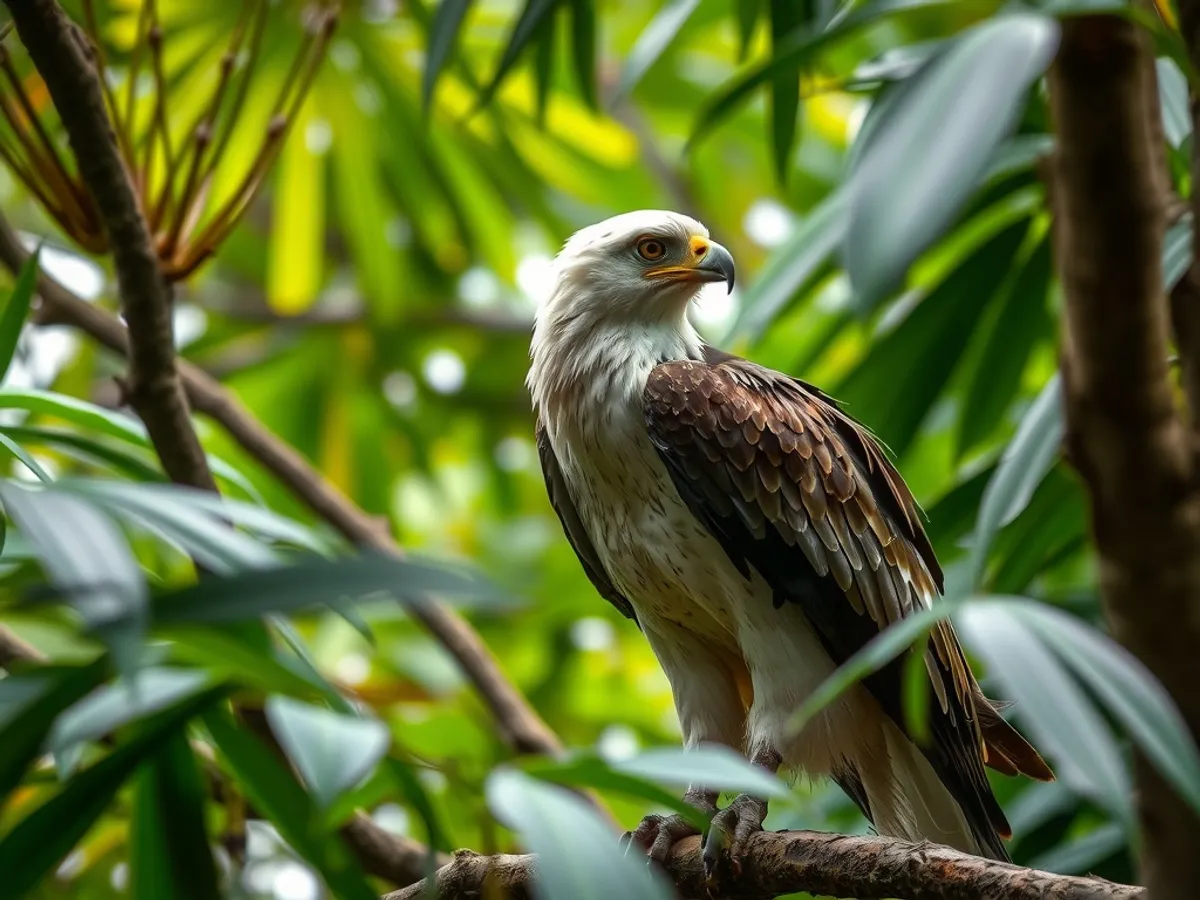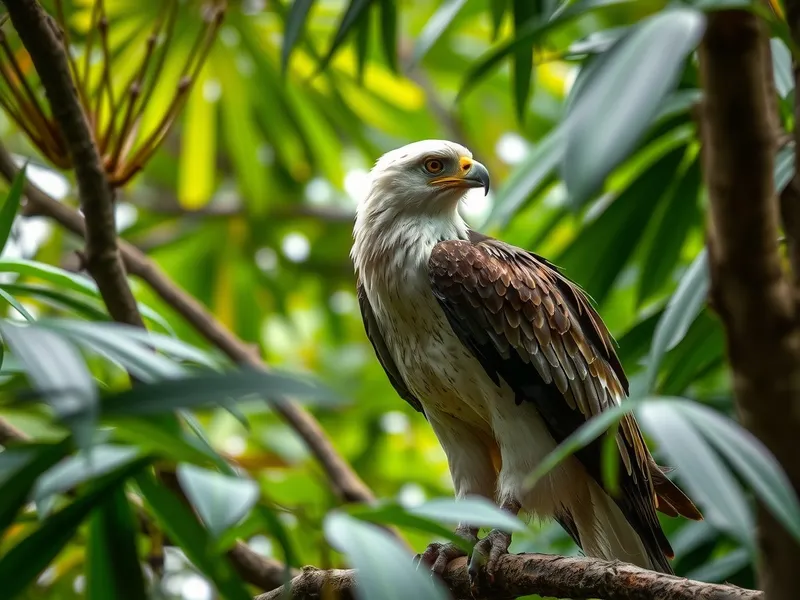
Philippine Eagle
Pithecophaga jefferyi

Meet the Philippine Eagle
The Philippine Eagle is a critically endangered bird of prey endemic to the forests of the Philippines. Renowned for its impressive size, it is one of the largest and most powerful eagles in the world, sporting a distinctive shaggy crest and piercing blue-gray eyes. This raptor is an apex predator, primarily hunting monkeys, flying lemurs, and other small mammals and birds. Due to extensive habitat loss and hunting, its population is alarmingly low, making it one of the rarest eagles on the planet.
Classification
Bird
Habitat
Tropical rainforest
Diet
Carnivore
Lifespan
30-60 years
Conservation
Critically Endangered
Weight
4.5–8 kg
📖Fascinating Facts
Largest Forest Raptor
The Philippine Eagle is one of the world’s largest and heaviest eagles, with females generally larger than males.
Forest Specialist
It depends on old-growth tropical forests for hunting and nesting, making it highly vulnerable to deforestation.
Slow Breeder
Philippine Eagles lay just one egg every two years, and both parents care for the chick until it becomes independent.
📋Detailed Description
The Philippine eagle (Pithecophaga jefferyi) is among the world’s largest and most powerful raptors, with adult females typically larger than males, reaching up to 102 cm in length and weighing as much as 8 kg. Its striking appearance includes a long, shaggy crest of brown and white feathers, a massive, deep blue-gray hooked bill, and strong yellow legs equipped with formidable talons. The eagle's wingspan can exceed 2.2 meters, allowing it to soar gracefully above the dense forest canopy. Its plumage is predominantly brown on the back and wings, with a white underside and legs, providing camouflage among the forest shadows. The Philippine eagle is a solitary and territorial bird, requiring large tracts of undisturbed primary forest to thrive. It is an apex predator, preying on a variety of arboreal mammals, birds, and reptiles, and is particularly known for hunting Philippine flying lemurs and monkeys. The species is monogamous, forming long-term pair bonds and occupying territories that can span up to 133 square kilometers. Its vocalizations are powerful and resonant, used for communication between mates and to assert territorial boundaries. The eagle's keen eyesight and silent flight make it an efficient hunter, while its slow reproductive rate and dependence on old-growth forests render it highly vulnerable to environmental changes.
💡 Did you know?
There are estimated to be fewer than 400 mature Philippine Eagles left in the wild, making it one of the world's rarest birds of prey.
🔬Research & Sources
Wikipedia Summary
The Philippine eagle, also known as the monkey-eating eagle or great Philippine eagle, is a critically endangered species of eagle of the family Accipitridae which is endemic to forests in the Philippines. It has brown and white-colored plumage, a shaggy crest, and generally measures 86 to 102 cm in length and weighs 4.04 to 8.0 kg.
Last Modified: 4/16/2025
🎭Behavior & Social Structure
Philippine eagles are diurnal and predominantly solitary, except during the breeding season when pairs cooperate in nest building and chick rearing. They are highly territorial, with pairs defending large home ranges using loud, high-pitched calls and aerial displays. Their hunting strategy involves perching silently for extended periods before launching swift, surprise attacks on prey in the mid- to upper canopy. Their diet is broad but primarily consists of mammals such as flying lemurs (Cynocephalus volans), civets, and monkeys (notably long-tailed macaques), as well as large birds, snakes, and occasionally monitor lizards. Feeding typically occurs in the early morning and late afternoon. Adults are known to cache surplus prey in tree forks near the nest. Social interactions are limited outside of breeding pairs and their offspring, as juveniles disperse upon reaching independence.
👶Reproduction & Life Cycle
The Philippine eagle is monogamous, with pairs maintaining long-term bonds. Breeding occurs once every two years due to the lengthy dependency period of the chick. Courtship involves aerial displays and mutual preening. Nests are constructed high in large dipterocarp trees, often over 30 meters above ground, and are reused for multiple seasons. The female lays a single egg, which is incubated for approximately 58–68 days, primarily by the female while the male provides food. After hatching, both parents feed and protect the chick, which fledges at around 4–5 months but remains dependent for up to 17–24 months. The extended parental care and low reproductive rate contribute to the species' vulnerability.
🛡️Adaptations & Survival
The Philippine eagle possesses several adaptations for life as a canopy-dwelling apex predator. Its large, powerful talons and robust legs enable it to capture and subdue sizeable, agile prey. The deep, hooked bill is specialized for tearing flesh. Its broad wings and relatively short tail allow for agile maneuvering through dense forest, while the shaggy crest may serve as a visual signal in communication or as camouflage. Exceptional binocular vision aids in detecting prey from great distances. Behaviorally, its solitary and territorial nature reduces competition for resources, and its ability to hunt a wide range of prey enhances its ecological flexibility.
🎨Cultural Significance
The Philippine eagle is a national symbol and is officially designated as the national bird of the Philippines. It is revered in local folklore as a symbol of strength, pride, and resilience. Indigenous peoples have traditionally respected the eagle, sometimes viewing it as a spiritual messenger. Its image appears on currency, stamps, and government insignia, and it features prominently in conservation campaigns. The eagle’s plight has galvanized national and international conservation efforts, making it a flagship species for forest preservation in the Philippines.
🔬Recent Research & Discoveries
Recent research has focused on the eagle’s breeding biology, genetic diversity, and habitat requirements, using satellite telemetry to track movements and identify critical habitats. Studies have revealed low genetic diversity, underscoring the importance of maintaining population connectivity. Conservation breeding programs, such as those at the Philippine Eagle Center in Davao, have achieved successful captive breeding and reintroduction efforts. Ongoing research is investigating the impacts of climate change and emerging diseases, as well as the effectiveness of community-based conservation initiatives. Advances in remote sensing are aiding habitat mapping and monitoring.
🎥Wildlife Videos

Watch an Endangered Philippine Eagle Chick Grow Up in Rare Video | Nat Geo Wild
Rare footage of a Philippine eagle family shows parents intensively caring for a single eaglet, and the fledgling learning to fly, ...
Nat Geo Animals

Hope for the King of the Skies | Documentary film
Hope for the King of the Skies (documentary film, 17 min, director Michal Gálik) This short documentary follows an expedition of ...
zooliberec

Philippine Eagle Description, Characteristics and Facts!
Hi, this is animal planet tv channel. my channale name animal planet tv . Animal videos and documentaries are offered on my ...
animal planet tv

Unique Wildlife of the Philippines
The Philippines is home to some of the rarest and most fascinating animals in the world—creatures you won't find anywhere else ...
KnowWell Files

"The Philippine Eagle: King of the Rainforest; A Conservation Journey | Evolution INSIGHTS | PART 4"
"Explore the awe-inspiring story of the Philippine Eagle, a majestic bird of prey that reigns supreme in the lush rainforests of the ...
Evolution INSIGHTS

The Strongest and Largest Eagle in The World
High intelligence predator with Excellent hunting skill, Eagles, the birds of prey, attacks its prey without mercy! If you want to see ...
Ben Sojo
🌍Habitat Information
The Philippine Eagle typically inhabits Tropical rainforest environments. Philippine Eagles have adapted to their environments with specialized features and behaviors.
Primary Habitat:
Tropical rainforest
More detailed habitat information will be available soon.
🛡️Conservation Status
The Philippine Eagle is currently classified as Critically Endangered. Conservation efforts are crucial for preserving this species for future generations.
Common Threats:
- 🏠Habitat loss and fragmentation
- 🌡️Climate change impacts
- 🎯Hunting and poaching
- 🏭Human-wildlife conflict
⚠️Threats & Conservation Challenges
The primary threats to the Philippine eagle are habitat loss due to deforestation, logging, agricultural expansion, and infrastructure development, which fragment and reduce the old-growth forests essential for nesting and hunting. Hunting and trapping, both for food and illegal wildlife trade, further endanger the species. With an estimated wild population of only 250–400 mature individuals, the eagle faces a high risk of extinction. Its slow reproductive rate and large territory requirements exacerbate its vulnerability. Conservation challenges include limited funding, enforcement difficulties, and the need for community engagement in habitat protection.
🔬Scientific Classification
Scientific Name
Pithecophaga jefferyi
Classification Hierarchy
🔍 About Taxonomic Classification
Taxonomic classification is a hierarchical system used by scientists to classify and organize living organisms based on shared characteristics and evolutionary relationships.
The system moves from broad categories (Kingdom) to increasingly specific ones, with each animal's scientific name typically consisting of its Genus and species.
📝Community Notes
Share your observations and insights about the Philippine Eagle with our community of wildlife enthusiasts.
Join Our Community
Sign in to share your observations and connect with fellow wildlife enthusiasts.
Sign In to ContributeNo community notes yet
Be the first to share your observations about the Philippine Eagle!
Explore Philippine Eagle
Select a tab above to learn more about this amazing animal.
📸Photo Gallery
No photos available for this animal yet.
🌟Discover More Wildlife
Continue your journey of discovery with more fascinating animals from our database
